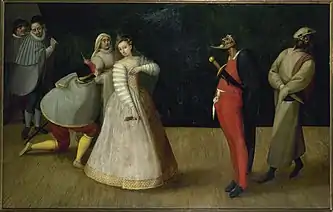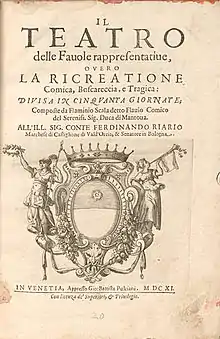Flaminio Scala
Flaminio Scala (27 September 1552 – 9 December 1624),[1] commonly known by his stage name, Flavio,[2] was an Italian stage actor of Commedia dell'Arte, scenario writer, playwright, director, producer, manager, agent, and editor. Considered one of the most important figures in Renaissance theatre, Scala is remembered today as the author of the first published collection of commedia scenarios, Il Teatro delle Favole Rappresentative,[3] short comic plays that served as inspiration to playwrights such as Lope de Vega, William Shakespeare, Ben Jonson, and Molière.[4]
Flaminio Scala | |
|---|---|
| Born | 27 September 1552[1] |
| Died | 9 December 1624 (aged 72) |
| Other names | Flavio, Claudione |
| Occupation | Commedia dell'Arte actor, scenario writer, playwright, director, producer, manager, agent, perfumier |
Notable work | Il Teatro delle Favole Rappresentative (1611) |
Life and work

Scala was born in Rome on 27 September 1552.[1] Little is known about his early life and his aristocratic family, except that his father's name was Giacomo.[2] Scala's career as an actor and began sometime prior to 1577 in Florence, where he is thought to have played the role of the innamorato in the Compagnia dei Comici Gelosi (1568-1604) whose name was established after the company's creed: Virtu`, fama ed honor ne fer gelosi; meaning, zealous to please their audience.[5] However, circa the year 1610, Scala became the company's resident stock character, Flavio.[6] Much of the company had been made up of actors who were seeking work after separating themselves from Ganassa.[7] Scala also held the position as director with the Ganassa Company from 1571, up until practicing under Francesco Andreini in 1577.[8] Members of the company included: Vittoria Piisimi, Isabella Arreini, Lodovico da Bologna, Giulio Pasquati, Simone da Bologna, Gabriele Panzanini, Orazio Nobili and a host of other notable playmakers.[9] Recordings also show that Scala also invested him time into another theatre company under the name, Confidenti, which also ended up being successful.[10] The company, Confidenti, made a home for itself in France in the year 1571.[11] While the company had established a positive reputation for itself, much of its members were shareholders.[12] This stock character made up the male half of the pair of young lovers that were central to the plots of scenarios in Italian Commedia dell'arte. Typically, the innamorati were as much in love with one another as they were with themselves and frequently kept apart by circumstances outside their control. Scala is credited with bringing the famous sixteenth-century actress and poet Isabella Andreini into I Gelosi to play opposite him as his inamorata and being considered the stage's first professional producer.[13] The sixteen-year-old wife of the actor Francesco Andreini (whose stage name was Capitan Spavento) went on to become such a celebrated actress in her own right that a new role known as the "Isabella" was created in her honor. She later died while traveling from Paris to Italy in 1604.[14] Following his work with I Gelosi, Scala was associated as an actor and occasionally as an agent with the i Accesi (Stimulated Ones), i Desiosi, (Desired Ones), and i Uniti (United Ones) from 1579 through 1596.[4]
Staging Scala's work
Scala wrote in a way that called for a specific facility in order for his scenarios to be performed for they called for a great amount of jeux de scene.[15] Although, Scala and the Gelosi company did not produce extravagant performances, Scala's detailed opening at the beginning of the scenario would deceive audiences to believe so.[16]
Personal life
Scala is thought to have one recorded child, a daughter named, Orsola.[17] Orsola is documented to be an active actress, normally playing the role of Flaminia, a play on femininity of Scala's first name.[18]
The Scala Collection

In 1611 Scala published the first collection of scenarios of Commedia dell'Arte plays, under the title Il Teatro delle Favole Rappresentative, also called the Scala collection.[19] Out of the fifty scenarios, only one is considered a tragedy, nine are considered elaborate fantasies and the remaining forty are comedies.[20] The Scala collection is most commonly used as a training tool for amateur performers.[21] Scala's approach to creating was unique. His scenarios did not require dialogue. The scenarios only provide in detail the action about to be done by the actor.[20] Between the seventeenth and eighteenth century's collections, documentation proves that 750 canovacci have survived over time.[21] It has been translated into English by Henry F. Salerno in 1967 as Scenarios of the Commedia dell'Arte.[22] A new Italian edition edited by Ferruccio Marotti was published in 1976.[23] A new partial translation (30 scenarios out of 50) Richard Andrews was published in 2008.[24]
Appearances in popular culture
Scala is represented in the 2007 musical The Glorious Ones with book and music by Lynn Ahrens and Stephen Flaherty. The New York production was based on the Francine Prose's 1974 novel of the same name.[25] During the musical's original Pittsburgh run, Flaminio Scala was played by Paul Schoeffler.[26] For the New York run, the role was played by Marc Kudisch.[27] In the Canadian premiere by the Toronto Civic-Light Opera Co., Scala was played by the company's artistic director Joe Cascone.[28]
Notes
- Richard Andrews (in the Introduction to Scala 2008) gives Scala's date of birth as 27 September 1552 and states it is based on a will that Scala drew up in 1616 (see p. ix in a preview at Google Books). This date is also given in Cappalletti 2008
- Landolfi 1993.
- Scala 1611.
- Cappelletti 2008.
- Oreglia, Giacomo (1968). The Commedia dell'Arte. New York: A Dramabook: Hill and Wang.
- Oreglia, Giacomo (1968). The Commedia dell'Arte. A Dramabook Hill and Wang.
- Duchartre, Pierre Louis. The Italian Comedy. New York: Dover Publications, Inc. p. 74.
- Oreglia, Giacomo. The Commedia dell'Arte. New York: A Dramabook Hill and Wang. p. 140.
- Oreglia, Giacomo (1968). The Commedia dell'Arte. A Dramabook: Hill and Wang.
- Nicoll, Allardyce (1963). The World of Harlequin: A Critical Study of the Commedia dell'Arte. Cambridge at The University Press.
- Duchartre, Pierre. The Italian Comedy. New York: Dover Publications, Inc. pp. 74–75.
- Oreglia, Giacomo (1968). The Commedia dell'Arte. New York: A Dramabook Hill and Wang. p. 140.
- Nicoll, Allardyce (1963). The World of Harlequin. Cambridge at The University Press. p. 172.
- Nicoll, Allardyce (1963). The World of Harlequin: A Critical Study of the Commedia dell'Arte. Cambridge at the University Press. p. 166.
- Duchartre, Pierre Louis. The Italian Comedy. New York: Dover Publications, Inc. p. 60.
- Duchartre, Pierre Louis. The Italian Comedy. New York: Dover Publications, Inc. p. 69.
- Nicoll, Allardyce (1963). The World of Harelquin: A Critical Study of the Commedia dell'Arte. Cambridge at The University Press. p. 171.
- Nicoll, Allardyce (1963). The World of Harlequin: A Critical Study of the Commedia dell'Arte. Cambridge at The University Press. p. 171.
- Farrell, Joseph. The History of the Italian Theatre. p. 111.
- Duchartre, Pierre Louis. The Italian Comedy. New York: Dover Publications, Inc. p. 51.
- Farrell, Joseph. The History of Italian Theatre. p. 111.
- Scala 1967.
- Scala 1976.
- Scala 2008.
- Isherwood 2007.
- Jones, Chris (30 April 2007). "The Glorious Ones". Variety.
- Isherwood, Charles (6 January 2008). "Those Smutty, Nutty Kids With Heart, Treading the Boards in Merry Olde Italy". The New York Times. ISSN 0362-4331. Retrieved 26 September 2020.
- "Joe Cascone". The Civic-Light Opera Co. Retrieved 26 September 2020.
Bibliography
- Cappelletti, Salvatore (2008). "Flaminio Scala (27 September 1552-9 December 1624)", pp. 244–249 in Seventeenth-Century Italian Poets and Dramatists. Dictionary of Literary Biography, volume 339, edited by Albert N. Mancini and Glenn Palen Pierce. Detroit: Gale Cengage Learning. ISBN 9780787681579.
- Isherwood, Charles (6 November 2007). "Those Smutty, Nutty Kids With Heart, Treading the Boards in Merry Olde Italy". New York Times. Retrieved 23 June 2013.
- Landolfi, Domenica (1993). "Flaminio Scala", pp. 437–449 in Comici dell'Arte: Corrispondenze G. B. Andreini, N. Barbieri, P. M. Cechini, S. Fiorillo, T. Martinelli, F. Scala, edited by Claudia Burattelli, Domenica Landolfi, and Anna Zinanni. Florence: Le Lettere. ISBN 9788871660868.
- Scala, Flaminio (1611). Il teatro delle favole rappresentative, overo La ricreatione comica, boscareccia, e tragica: Divisa in cinquanta giornate, composte da Flaminio Scala detto Flavia Comico del Sereniss. Sig. Duca di Mantova. [The Theater of Tales for Performance, or for Comic, Rustic, and Tragic Recreation, Divided into Fifty Days, and Composed by Flaminio Scala, Named Flavio, Comedian of the Most Serene Lord Duke of Mantua]. Venice: Giovanni Battista Pulciani. Copy at Bavarian State Library website.
- Scala, Flaminio; Salerno, Henry F., translator (1967). Scenarios of the Commedia del'Arte: Flaminio Scala's Il Teatro delle Favole Rappresentative, foreword by Kenneth McKee. New York: New York University Press. OCLC 186077.
- Scala, Flaminio; Marotti, Ferruccio, editor (1976). Il Teatro delle Favole Rappresentative. Milan: Il Polifilo. OCLC 2856429, 898901306.
- Scala, Flaminio; Andrews, Richard, translator (2008). The Commedia dell'arte of Flaminio Scala: A Translation and Analysis of 30 Scenarios. Lanham, MD: Scarecrow Press. ISBN 9780810863606.
External links
| Wikimedia Commons has media related to Flaminio Scala. |